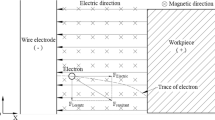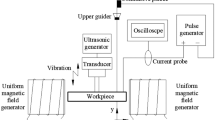Abstract
In this paper, a magnetic field-assisted WEDM-ECM complex process (MF-assisted WEDM-ECM) is proposed to solve the problems of traditional low-speed wire electrical discharge machining (WEDM-LS) of NiTi SMA, including low machining efficiency, high workpiece surface roughness, and large recast layer thickness. Electrolytic machining is used to remove the recast layer, and magnetic field-assisted method is used to reduce the surface roughness and improve the machining efficiency. Firstly, based on the double-layer model the removal thickness of recast layer is deduced, and the removal thickness of recast layer under different machining parameters is analyzed. In addition, based on the influence of magnetic field on discharge channel, the single spark crater analytical model is modified. Based on this model, combined with the electrochemical corrosion rate and the wire electrode vibration response equation, a continuous discharge corrosion mathematical model is established to predict the surface topography of the workpiece, and the simulation analysis is carried out. Finally, comparison of the experimental results of traditional WEDM-LS, MF-assisted WEDM-LS, ultrasonic vibration (USV)-MF complex-assisted WEDM-LS, and MF-assisted WEDM-ECM in machining NiTi SMA reveals that MF-assisted WEDM-ECM has the best machining performance. Compared with traditional WEDM-LS, the material removal rate (MRR) of MF-assisted WEDM-ECM was increased by 26.2%, the surface roughness value was reduced by 19.2%, and the thickness of recast layer was reduced by 44.25%. The average errors of the experimental and predicted values of workpiece surface roughness, recast layer removal thickness, and kerf width are 8.3%, 6.41%, and 3.58%, respectively, which verified the accuracy of the theoretical model proposed in this paper.

























Similar content being viewed by others
References
Yan BY, Zhang YQ, Jiang SY (2021) Mechanical properties and fracture mechanisms of martensitic NiTi shape memory alloy based on various thermomechanical-processing microstructures. J Alloys Compd 883:160797. https://doi.org/10.1016/j.jallcom.2021.160797
Gupta NK, Somani N, Prakash C, Singh R, Walia AS, Singh S, Pruncu CI (2021) Revealing the WEDM process parameters for the machining of pure and heat-treated titanium (Ti-6Al-4V) alloy. Materials 14:2292. https://doi.org/10.3390/ma14092292
Chen Z, Zhang YM, Zhang GJ, Huang Y, Liu CH (2017) Theoretical and experimental study of magnetic-assisted finish cutting ferromagnetic material in WEDM. Int J Mach Tool Manuf 123:36–47. https://doi.org/10.1016/j.ijmachtools.2017.07.009
Wang Y, Li ZX, Yao SW, Wu CZ (2020) Analysis of discharge channel characteristics based on plasma flow and heat transfer in USV-MF complex assisted WEDM-LS. Int J Heat Mass Transfer 150:119268. https://doi.org/10.1016/j.ijheatmasstransfer.2019.119268
Zhang YM, Zhang Z, Zhang GJ, Li WY (2020) Reduction of energy consumption and thermal deformation in WEDM by magnetic field assisted technology. Int J Precis Eng Manuf Green Technol 7:391–404. https://doi.org/10.1007/s40684-019-00086-5
Zhang Z, Huang H, Ming WY, Xu Z, Huang Y, Zhang GJ (2016) Study on machining characteristics of WEDM with ultrasonic vibration and magnetic field assisted techniques. J Mater Process Technol 234:342–352. https://doi.org/10.1016/j.jmatprotec.2016.04.007
Ahmed S, Speidel A, Murray JW, Ahmed N, Cuttell M, Clare AT (2022) Electrolytic-dielectrics: a route to zero recast electrical discharge machining. Int J Mach Tool Manuf 181:103941. https://doi.org/10.1016/j.ijmachtools.2022.103941
Bains PS, Sidhu SS, Payal HS (2016) Study of magnetic field-assisted ED machining of metal matrix composites. Mater Manuf Processes 31:1889–1894. https://doi.org/10.1080/10426914.2015.1127953
Rajurkar KP, Levy G, Malshe A, Sundaram MM, McGeough J, Hu X, Resnick R, DeSilva A (2006) Micro and nano machining by electro-physical and chemical processes. CIRP Ann 55:643–666. https://doi.org/10.1016/j.cirp.2006.10.002
Kurita T, Hattori M (2006) A study of EDM and ECM/ECM-lapping complex machining technology. Int J Mach Tool Manuf 46:1804–1810. https://doi.org/10.1016/j.ijmachtools.2005.11.009
Nguyen MD, Rahman M, Wong YS (2013) Transitions of micro-EDM/SEDCM/micro-ECM milling in low-resistivity deionized water. Int J Mach Tool Manuf 69:48–56. https://doi.org/10.1016/j.ijmachtools.2013.03.008
Nguyen MD, Rahman M, Wong YS (2012) Simultaneous micro-EDM and micro-ECM in low-resistivity deionized water. Int J Mach Tool Manuf. 54-55:55–65. https://doi.org/10.1016/j.ijmachtools.2011.11.005
Nguyen MD, Rahman M, Wong YS (2013) Modeling of radial gap formed by material dissolution in simultaneous micro-EDM and micro-ECM drilling using deionized water. Int J Mach Tool Manuf 66:95–101. https://doi.org/10.1016/j.ijmachtools.2012.12.001
Zhang Y, Xu ZY, Zhu D, Xing J (2015) Tube electrode high-speed electrochemical discharge drilling using low-conductivity salt solution. Int J Mach Tool Manuf 92:10–18. https://doi.org/10.1016/j.ijmachtools.2015.02.011
Wu XY, Li SJ, Jia Z, Xin B, Yin XC (2019) Using WECM to remove the recast layer and reduce the surface roughness of WEDM surface. J Mater Process Technol 268:140–148. https://doi.org/10.1016/j.jmatprotec.2019.01.016
Wu XY, Li SJ, Zhao W, Tang L, Li ZP (2019) Experiment investigation of using wire electrochemical machining in deionized water to reduce the wire electrical discharge machining surface roughness. Int J Adv Manuf Technol 102:343–353. https://doi.org/10.1007/s00170-018-3196-y
Zhang M, Liu ZD, Pan HW, Deng C, Qiu MB (2021) Effect of no-load rate on recast layer cutting by ultra fine wire-EDM. Chin J Aeronaut 34:124–131. https://doi.org/10.1016/j.cja.2020.08.007
Liu WD, Zhang H, Luo Z, Zhao CF, Ao SS, Gao F, Sun YB (2018) Electrochemical micromachining on titanium using the NaCl-containing ethylene glycol electrolyte. J Mater Process Technol 255:784–794. https://doi.org/10.1016/j.jmatprotec.2018.01.009
Shabgard M, Ahmadi R, Seyedzavvar M, Oliaei SNB (2013) Mathematical and numerical modeling of the effect of input-parameters on the flushing efficiency of plasma channel in EDM process. Int J Mach Tool Manuf 65:79–87. https://doi.org/10.1016/j.ijmachtools.2012.10.004
Ikai T, Fujita I, Hashigushi K (1992) Heat input for crater formation in the electric discharge machining. Trans Inst Electr Eng Jpn 112:943–949. https://doi.org/10.1541/ieejias.112.943
Li MH (1989) Theory of EDM. National Defense Industry Press, Beijing
Shabgard MR, Gholipoor A, Mohammadpourfard M (2018) Numerical and experimental study of the effects of ultrasonic vibrations of tool on machining characteristics of EDM process. Int J Adv Manuf Technol 96:2657–2669. https://doi.org/10.1007/s00170-017-1487-3
Wang Y, Wang Q, Ding ZJ, He DX, Xiong W, Chen SY, Li ZX (2018) Study on the mechanism and key technique of ultrasonic vibration and magnetic field complex assisted WEDM-LS thick shape memory alloy workpiece. J Mater Process Technol 261:251–265. https://doi.org/10.1016/j.jmatprotec.2018.06.006
Jameson EC (1970) Electrical discharge grinding. Iee:135–142
Roy T, Datta D, Balasubramaniam R (2018) Numerical modelling and simulation of surface roughness of 3-D hemispherical convex micro-feature generated by reverse micro-EDM. Int J Adv Manuf Technol 97:979–992. https://doi.org/10.1007/s00170-018-1971-4
Rebelo JC, Dias AM, Kremer D, Lebrun JL (1998) Influence of EDM pulse energy on the surface integrity of martensitic steels. J Mater Process Technol 84:90–96. https://doi.org/10.1016/S0924-0136(98)00082-X
Funding
The authors declare that this work was sponsored by Natural Science Foundation of Shanghai.
Author information
Authors and Affiliations
Corresponding author
Ethics declarations
Consent to participate
The authors declare that they participated in this paper willingly.
Consent for publication
The authors declare to consent to the publication of this paper.
Competing interests
The authors declare no competing interests.
Additional information
Publisher’s Note
Springer Nature remains neutral with regard to jurisdictional claims in published maps and institutional affiliations.
Rights and permissions
Springer Nature or its licensor (e.g. a society or other partner) holds exclusive rights to this article under a publishing agreement with the author(s) or other rightsholder(s); author self-archiving of the accepted manuscript version of this article is solely governed by the terms of such publishing agreement and applicable law.
About this article
Cite this article
Wang, Y., Tang, CC., Chai, HY. et al. Study on removal of recast layer of NiTi shape memory alloy machined with magnetic field-assisted WEDM-ECM complex process. Int J Adv Manuf Technol 129, 4335–4354 (2023). https://doi.org/10.1007/s00170-023-12588-3
Received:
Accepted:
Published:
Issue Date:
DOI: https://doi.org/10.1007/s00170-023-12588-3




